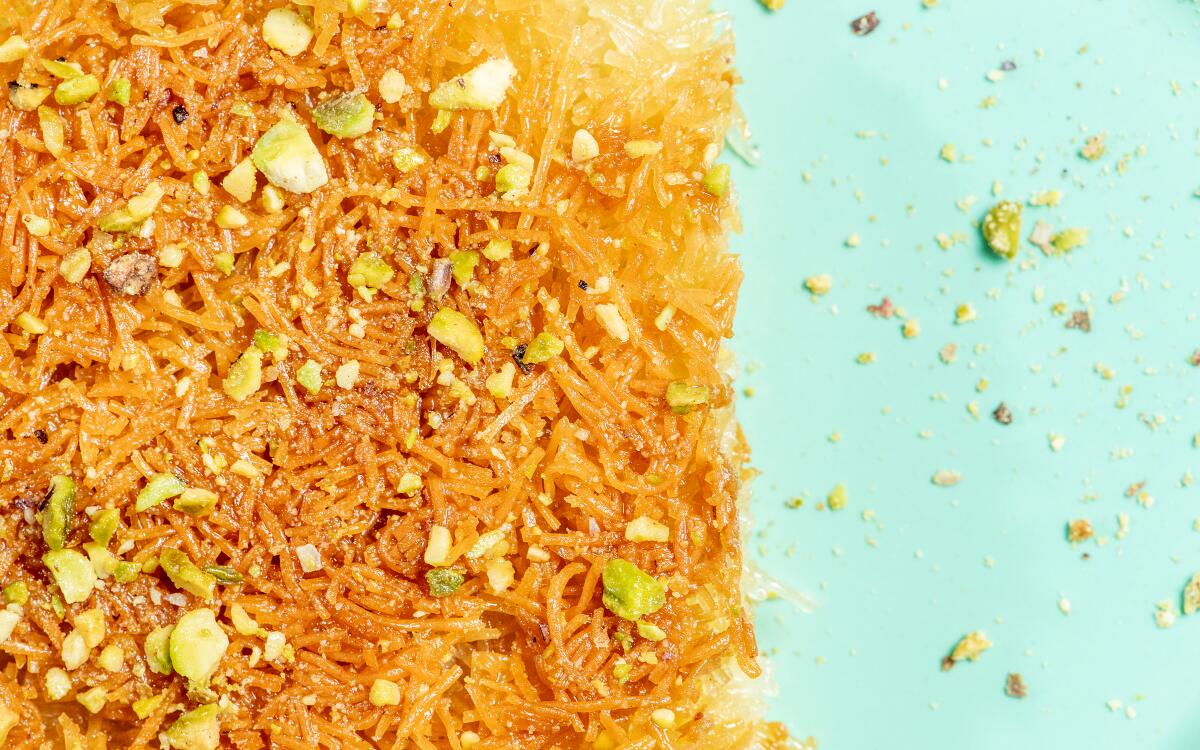Knafeh Nabulseyeh

Knafeh is a national institution, made and served all over the Middle East, and no celebration is complete without it. It’s particularly associated with Nablus, on the West Bank, where the shredded filo pastry is filled with the city’s trademark firm, white, salty Nabulsi cheese. A filling of just nuts and cinnamon is called knafeh Arabiyeh — “Arabic knafeh.” Nabulsi cheese is not widely available, though, so we’ve used a combination of firm mozzarella, ricotta and feta. Find frozen kataifi at markets that specialize in Middle Eastern ingredients, such as Kozanian’s Ranch Market in Glendale.
To make the syrup, put the water and sugar into a medium saucepan and place over medium-high heat. Bring to a boil and add the lemon juice, swirling the pan frequently until the sugar dissolves. Remove from the heat, stir in the orange blossom water and set aside until completely cool.
To make the knafe, preheat the oven to 375°F. Liberally butter the base and sides of a baking dish, about 9 x 13 inches/23 x 33 centimeters and 1½ inches/4 centimeters high. Place the pastry in a food processor, in three or four batches, and blitz a few times until the strands are about ¾ inch/2 centimeters long. Transfer to a bowl, pour in the melted butter and toss evenly so that all the kataifi is coated.
Put the mozzarella, ricotta, feta, sugar, lemon zest, salt and orange blossom water into a separate bowl. Mix to combine and set aside.
Press about two-thirds of the kataifi mixture into the base of the prepared baking dish. Press down quite firmly; you want it to be as compact as possible. It should rise about ¾ inch/2 centimeters up the sides of the pan. Evenly top with the cheese mixture, spreading very gently so the kataifi layer is covered but doesn’t get moved about. Finally, top with the remaining kataifi, pressing down firmly to cover any exposed cheese. Even out the top, then cover with a piece of parchment paper about the size of the sheet. Top with a separate baking dish, about the same size, so that the knafeh is compressed. Bake for 30 minutes, then remove the top dish and parchment and bake for another 25 minutes or until deeply golden around the edges and browned on top.
Slide a knife around the edges of the tray and let cool for about 5 minutes before flipping over onto a platter or cutting board. Slowly drizzle with 1 cup/240 milliliters of the sugar syrup, then set aside for 5 minutes, for the syrup to be absorbed. Sprinkle with the pistachios and serve warm, preferably, or at room temperature later on.
Get our Cooking newsletter.
Your roundup of inspiring recipes and kitchen tricks.
You may occasionally receive promotional content from the Los Angeles Times.















